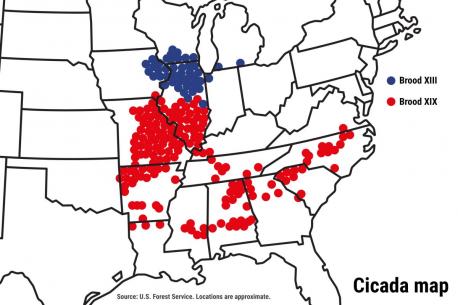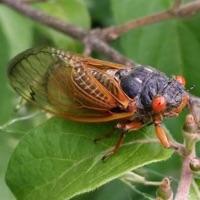Results: Cicadas - Double Brood Emergence!
Published on 04/13/2024
Billions of cicadas are expected to surface later this spring after years of living underground as two different broods in a rare double brood emergence. One that appears every 13 years and another that appears every 17 years. And they will emerge simultaneously.

QUESTIONS
GO to COMMENTS
Comments
1.
1.
Cicadas are divided into groups called broods based upon when they emerge. The two broods in this case are periodical, meaning they only come above ground once every 13 or 17 years. The 13 year brood is known as Brood XIX or the Great Southern Brood. The 17 year brood is known as Brood XIII or the Northern Illinois Brood. Are you aware of these facts?

Northern Illinois, southern Wisconsin, eastern Iowa and northwest Indiana are likely to see Brood XIII.
8%
165 votes
Central and southern Illinois, Missouri, Kentucky, Tennessee, Virginia, Maryland, North Carolina, South Carolina, Georgia, Alabama, Mississippi, Louisiana and Arkansas are due to get the Brood XIX cicadas.
15%
303 votes
These broods are expected to emerge in late April to mid May depending on location and weather.
16%
321 votes
All
11%
215 votes
None
62%
1245 votes
2.
2.
It's rare to see a double brood emergence. This year marks the first time the two broods have emerged in the same year since 1803 and won't happen again for another 221 years in 2245. Do you know any of these facts? Annual cicadas appear every year but periodical broods only emerge in certain years.
17%
338 votes
They wait until the soil temperature reaches 65 degrees Fahrenheit at 8 inches deep to emerge.
8%
165 votes
Scientists theorize that by coming out in large numbers all at once, it helps ensure that enough of them will survive to spawn offspring.
12%
240 votes
They have many predators. They don't bite or sting, they aren't poisonous and don't carry disease. They will be loud and numerous but they are harmless and don't pose a risk to garden plants.
20%
392 votes
All
9%
188 votes
None
59%
1183 votes
3.
3.
The way to tell the annual and periodical cicadas apart is that the periodicals tend to emerge in the spring and the annuals will emerge later in the summer in August. There are numerous species of annual cicadas, many of them are large and greenish. Periodical cicadas are smaller and mostly black with bright red eyes and orange tinged wings and legs. Are you aware of these facts?

The adult life cycle is just a few weeks, but their emergence will be staggered, so there will be about six weeks of cicadas.
14%
273 votes
If you live in an area where the cicadas will make their appearance you can download the Cicada Safari Map where you can submit photographs of the cicadas that you see. After the photographs are verified they will be posted to the live map. The photographs are also sent to scientists who can map when and where the cicadas are emerging and can predict future cicada activity.
10%
191 votes
Periodical cicadas are often incorrectly called locusts. Locusts are grasshoppers and cicadas are more closely related to aphids.
12%
241 votes
All
8%
150 votes
None
67%
1344 votes
4.
4.
In 2021 the Brood X cicadas emerged after 17 years underground. They could be found in Maryland, Delaware, Pennsylvania, Indiana, Ohio, and eastern Tennessee. Do you remember the Brood X cicadas of 2021? Yes
22%
445 votes
No
78%
1555 votes
COMMENTS


